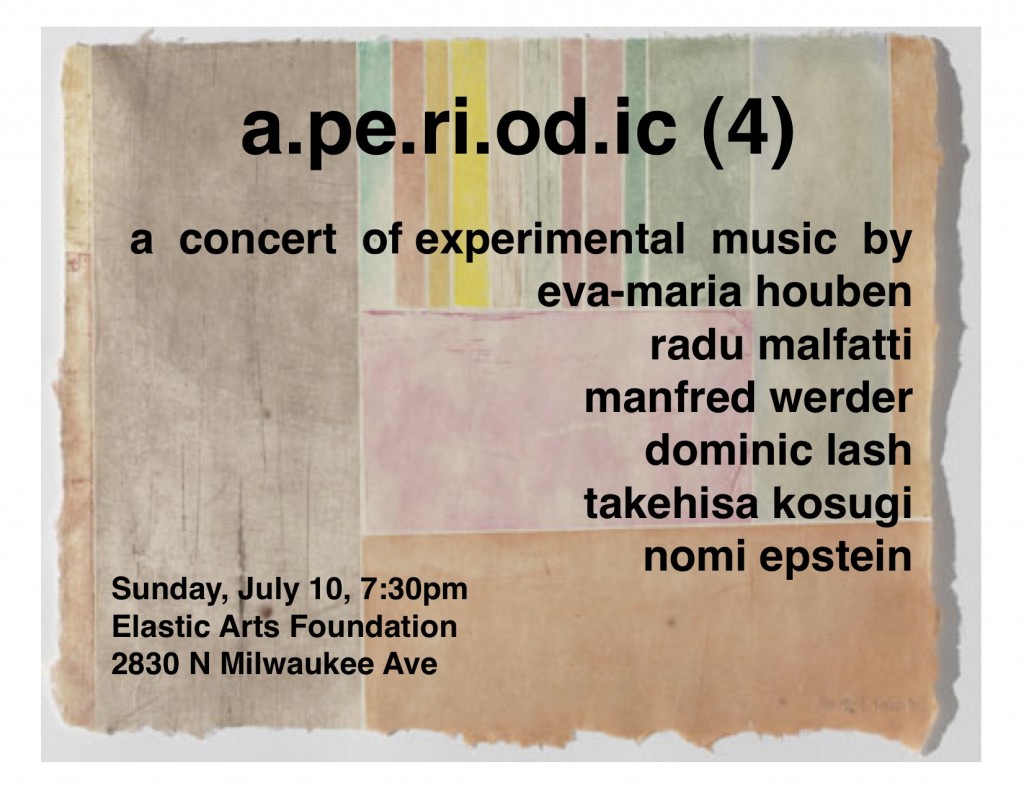aperiodic is a wonderful new concert series in Chicago, curated by Nomi Epstein. She says:
For me, it came out of a number of things: my appreciation and enjoyment of that music, and my seeing that I didn’t have the option of sharing a lot of this repertoire in Chicago. On top of that, I have experience with curating and putting together concerts, and I’ve done it before, so it’s something I knew I could get off the ground at least a little bit. But it was the kind of music that I wanted to hear and be a part of in performance, and to create a venue for it. A lot of my colleagues are in different parts of the US and Western Europe, and they are making this music happen, but it wasn’t really happening here.
I attended aperiodic (3) on May 22nd, and participated in one of the pieces: Jürg Frey’s more or less normal. It’s an enlightening process to study, rehearse, and play a piece, rather than just glancing at the score and seeing how it happens once. In this case, the question that everyone brought to the first rehearsal was about how to match the metronome markings. Should we keep some device going with a silent pulse in front of us? The markings ranged from 40 to 69, and changed often enough to cause some insecurity. Word had come from the composer not to worry about it, but to approximate them as best we could. I for one knew that my approximation would not be a good one. All the players are start together, but each in a different part of the score, and are to end at a different point in the score as well. Because of the tempo changes and varying lengths of the sections, it would be quite difficult to calculate exactly how parts should align, if performed perfectly according to the metronome markings. What I’m sure of, is that we never aligned the same way twice. But that in itself is fascinating, that the relative durations of each part changed so dramatically. Each person’s perception of time, and the relation between the results of those perceptions, shifted according to some indefinable mix of internal and external circumstances. It is not about a perfect execution. It is about a concerted effort, and the variation of results from that effort.
There is a similar and more explicit interest in the variability of perception in Joe Kudirka’s canon, which involves pitch matching between the players: “There should be no planning or coordination as to what the pitch(es) should be – there are no wrong notes. A player simply makes an educated guess as to what the pitch to be imitated is, and plays it – no wavering.”
Matt Sargent’s Tide for nine sliding instruments has five types of action—rise, fall, sustain, return, silence—for each of the nine sliding instruments. It all seems so simple and so natural, and yet like the Frey it sets up a complex set of interactions. Epstein, who participated in the performance, reflected,
Similar to the Frey piece, this one is dependent upon relationships between instruments, this time the relationship being that each player ends their glissando at a pitch point that they hear within the ensemble. They must always listen while playing/singing, and the ending pitch they find may be heard at any point during their 10 seconds of noise. It is nearly impossible to keep that pitch in one’s head while multiple glissandi are going on around you, and all the while you are also glissing. Similar to the Frey, it sets up a nearly impossible feat of trying, trying, and knowing you are probably failing, but in a most beautiful way.
Mabel Kwan’s performance of Kunsu Shim’s Intermezzi #2 and 3 brought out wonderful resonances on what may not be the most forgiving of pianos. The wrist and hand motions and finger changes brought out sound transformations which I don’t yet understand, but will continue to explore.
Chiyoko Szlavnics’ Acclines had a real tension. Maybe it was because I had seen the line notations of the score, but I felt a real tension of coherence around each unison or quasi-unison. The closest analogy I can find is of several people on the same tightrope.
Mirror, by Cristyn Magnus, was very funny, not because it encouraged comedic performances from the players (it did not), but because it set up a kind of a game of sonic matching. It needed some time to reveal itself, but there was a palpable shift in engagement in the audience as they began to understand the laws of play in action.
The program for the upcoming concert on July 10th includes:
Manfred Werder: stück 1998
Dominic Lash: from four to fifteen*
Nomi Epstein: Text Series
Eva Maria-Houben: pismo beach*
Takehisa Kosugi: Distance for Piano
Radu Malfatti: sprachlos
*world premiere
There is a nice symmetry in the return of Werder’s stück 1998 to Chicago, since one of the earliest performances took place there. I heard pages 647-652 in New York several months ago. The history so far of the “one successive and intermittent performance” of the piece is fascinating, as is the direct, subjective experience of any portion of it. Several thousand pages remain to be performed.
And here is footage of a performance from the first aperiodic concert, Antoine Beuger’s rain/east wind/ocean, played by Lee Weisert and Nomi Epstein, the two founders of the series.
three drops of rain/east wind/ocean by Antoine Beuger/Aperiodic (1) from Aperiodic on Vimeo.

